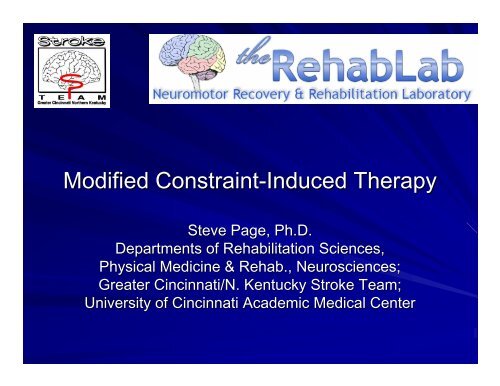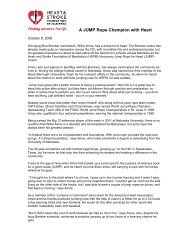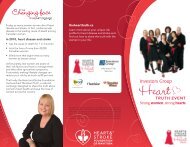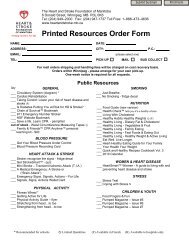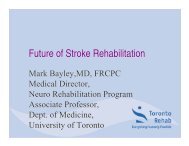Create successful ePaper yourself
Turn your PDF publications into a flip-book with our unique Google optimized e-Paper software.
<strong>Modified</strong> <strong>Constraint</strong>-<strong>Induced</strong> <strong>Therapy</strong><br />
Steve Page, Ph.D.<br />
Departments of Rehabilitation Sciences,<br />
Physical Medicine & Rehab., Neurosciences;<br />
Greater Cincinnati/N. Kentucky Stroke Team;<br />
University of Cincinnati Academic Medical Center
If you are a stroke patient…<br />
And I asked you to reach for something, with<br />
which hand would you be more likely to<br />
perform the task; the affected or unaffected<br />
hand<br />
Unaffected<br />
Why<br />
– Learned Nonuse – a behavioral suppression of<br />
movement (not biologically based)<br />
– Operant conditioning<br />
Success/punishment-operant conditioning<br />
-therapy/compensation
So, recovery isn’t t just “in the brain”…
Practice, Plasticity and Stroke<br />
Pt exhibits learned<br />
nonuse<br />
– Easier to use less<br />
affected than more<br />
affected<br />
Training =>Use-<br />
induced brain<br />
reorganization<br />
– Changes in cortical<br />
motor area sizes in the<br />
damaged hemisphere in<br />
abductor pollicis brevis<br />
(APB) muscle before<br />
and after training<br />
Liepert et al., 1999
<strong>Constraint</strong>-induced induced therapy is<br />
born…<br />
2 components to induce<br />
repeated practice with the<br />
affected limb<br />
– Pts. Participate in 6 hour training<br />
sessions on 10 consecutive<br />
weekdays<br />
– Wear sling 90% of all waking<br />
hours during same 2 weeks<br />
Increases more affected limb<br />
use & function in acute &<br />
chronic CVA pts.<br />
Repeated practice => brain<br />
reorganization => improved<br />
motor function
Lots and lots of studies support<br />
“Lots and lots of practice”<br />
Teasell; EBRSR
ExCITE Trial
VECTORS TRIAL (2007) – is<br />
earlier and more intensive better<br />
Very Early <strong>Constraint</strong>-<br />
<strong>Induced</strong> <strong>Therapy</strong> for<br />
Recovery from Stroke<br />
CI <strong>Therapy</strong> no better<br />
than regular therapy<br />
When more is given,<br />
worse outcomes<br />
Buttressed by several<br />
animal studies<br />
(Schallert et al)<br />
Supported by other<br />
clinical data (Boake et<br />
al., 2007, Neurorehab<br />
Neural Repair)
But are we really here yet<br />
CONSTRAINT-<br />
INDUCED<br />
THERAPY FOR SALE
Drug development<br />
Appropriate dosing is established early on in drug<br />
development process
Timing, Intensity, and Duration of<br />
Rehabilitation for Hip and Stroke Fracture<br />
NIH, 2001<br />
“Current medical practice has<br />
been heavily influenced by<br />
reimbursement rules, with<br />
comparatively little empirical<br />
research on optimal treatment<br />
schedules.”<br />
In other words:<br />
We still don’t know the optimal<br />
duration with which stroke<br />
rehabilitation should be delivered<br />
It also may differ from one<br />
technique to another.
Some recent studies showing that<br />
task specific trainingg => plasticity:<br />
Do you really need “lots and lots”<br />
“any technique that induces a patient to use an affected limb…should be<br />
considered therapeutically efficacious. This factor is likely to produce the<br />
use-dependent cortical reorganization.”<br />
Taub; J Rehabil Res Dev 1999: p. 243.<br />
Non-disabled humans<br />
Classen et al; J Neurophysiol 1998<br />
– “15 or 30 min of continuous training (finger tapping) were required ed in<br />
most of the subjects and, on two occasions, as little as 5 or 10 minutes”<br />
Humans with stroke<br />
Butefisch et al; J Neurol Sci 1995<br />
– 15 min./day; 2 times/day<br />
Dean & Shepherd; Stroke 1997<br />
– 30 min/day; 10 weekdays over a 2 week period<br />
Luft et al; JAMA 2004<br />
– 1 hour, 3 times a week, for 6 weeks<br />
Motor learning evidence – distributed practice > massed practice (clumping)
<strong>Modified</strong> constraint-induced induced therapy:<br />
Translating “basic research” to care<br />
<strong>Therapy</strong> 3 times/week for ½<br />
an hour<br />
Practice with the more<br />
affected arm 5 hours/day 5<br />
days/week<br />
– Tasks pts. choose<br />
Reimbursable<br />
Not taxing<br />
What patients are used to<br />
(i.e., consistent w. OP tx<br />
regimen)
Study Criteria That We Typically Use:<br />
Inclusion Criteria:<br />
1. hx of no more than one stroke;<br />
2. ability to selectively actively extend at least 10° at the<br />
metacarpophalangeal and interphalangeal joints and 20° at the<br />
wrist;<br />
3. stroke experienced > 12 months prior to study enrollment;<br />
4. > 69 on the <strong>Modified</strong> Mini Mental Status Examination<br />
5. age > 18 < 80 years;<br />
6. more affected arm nonuse, defined as a score < 2.5 on the<br />
Motor Activity Log.<br />
Exclusion Criteria:<br />
1. excessive spasticity, (> 3 on <strong>Modified</strong> Ashworth Spasticity<br />
Scale);<br />
2. > 4 on a 10-point visual analog scale;<br />
3. still enrolled in any form of physical rehabilitation;
Results<br />
Action Research Arm<br />
Test (primary<br />
outcome measure)<br />
(functional limitation)<br />
– mCIT = +10.8<br />
– TR = +3.00<br />
– CON = +0.90<br />
– ARA (F {3, 31} =<br />
13.14, p < .0001)<br />
60<br />
40<br />
20<br />
0<br />
Fine Motor Skill Improves for mCIT; Changes are<br />
Nominal for Others<br />
PRE-1 PRE-2 POST<br />
mCIT<br />
TR<br />
CON<br />
Page et al., Phys Ther; 2008
Repeatable<br />
These findings are…<br />
– mCIT used in several clinical sites across US<br />
– Subacute stroke (< 1 year post CVA)<br />
Page, S.J., Sisto, S.A., Johnston, M.V., Levine, P.,<br />
Hughes, M. <strong>Modified</strong> constraint induced therapy: A case<br />
study. Arch Phys Med Rehabil 2002; 83 (2): 286-90.<br />
Page, S.J., Sisto, S., Johnston, M., Levine, P. <strong>Modified</strong><br />
constraint-induced induced therapy after subacute stroke: A<br />
preliminary study. Neurorehabil Neural Repair 2002; 16<br />
(3): 223-28.<br />
28.<br />
Page, S.J., Sisto, S., Johnston, M.V., Levine, P. Hughes,<br />
M. <strong>Modified</strong> constraint induced therapy: A randomized,<br />
feasibility and efficacy study. J Rehabil Res Dev 2001; 38<br />
(5): 583-590.<br />
590.
These findings are repeatable…<br />
– Chronic stroke (> 1 year post CVA)<br />
Page SJ, Sisto SA, Levine P. <strong>Modified</strong> constraint-<br />
induced therapy in chronic stroke. Am J Phys Med<br />
Rehabil 2002 Nov;81(11):870-5.<br />
– Acute stroke<br />
• Page SJ, Levine P, Leonard AC. <strong>Modified</strong><br />
constraint-induced induced therapy in acute stroke: a<br />
randomized controlled pilot study. Neurorehabil<br />
Neural Repair. 2005 Mar;19(1):27-32.<br />
– Mechanism<br />
Szaflarski JP, Page SJ, et al. Use dependent cortical<br />
organization following mCIT. Arch Phys Med Rehabil<br />
2006.
There are other efficacious dosing<br />
strategies too (and I don’t t care<br />
which you use)<br />
3 Hours/day (Sterr et al, 2002, Arch Phys<br />
Med Rehabil)<br />
2 Hours/day (Wu et al 2007; Arch Phys<br />
Med Rehabil; ; Wu et al 2007; Neurorehabil<br />
Neural Repair)<br />
1.5 hours/day (Taub et al, CSM<br />
conference, 2007)
Some tips for administering mCIT<br />
Inclusion/Exclusion – how do you MEASURE if<br />
someone is eligible<br />
“I I know my intervention works.” Really! How if<br />
you don’t t measure outcomes<br />
– Amount of active movement<br />
– Amount of affected arm use<br />
– Spasticity<br />
Behavioral Contract<br />
Doing the <strong>Therapy</strong><br />
– Sling Use<br />
– <strong>Therapy</strong>
Flowchart for patient screening<br />
Affected limb nonuse<br />
(< 2.5 on Motor Activity Log)<br />
Active extension in affected wrist & fingers<br />
"Good" ROM in other joints,<br />
Subluxation or other comorbidities<br />
No cognitive deficits (MMSE)<br />
Things that MAY exclude patients:<br />
Ambulation<br />
Family support<br />
Others
How much movement is<br />
needed to start mCIT
Minimum Motor Criteria<br />
1. Extension of the hemi wrist<br />
greater than 10°<br />
2. Some active ABDuction of the carpal<br />
metacarpal joint of the thumb<br />
3. 10° of active extension in, at least, 2<br />
additional digits.<br />
(Should be able to do the movement 3x in 1 min.)
Practical Application:<br />
Motor Criteria: What You Look For on the Phone<br />
Able to actively lift hand from a<br />
drooped position and raise thumb and<br />
at least two fingers. (EMORY)<br />
Roughly enough finger extension to<br />
release a tennis ball (Taub, higher<br />
functioning group)<br />
The ability to lift a wash rag off a tabletop using<br />
any type of prehension they could manage, and<br />
then release the rag. (Taub, lower functioning<br />
group)<br />
Movement should be enough to pick up and<br />
release a washcloth. (U. OF OREGON)
CIT<br />
There are some studies showing<br />
CIT/mCIT efficacy outside of<br />
“established” motor criteria<br />
– Taub et al: “lift a wash rag off a tabletop using any type of prehension they<br />
could manage, and then release the rag” (Taub E, E Uswatte G, G Pidikiti R. R<br />
<strong>Constraint</strong>-<strong>Induced</strong> Movement <strong>Therapy</strong>: a new family of techniques with<br />
broad application to physical rehabilitation--<br />
--a a clinical review. J Rehabil Res<br />
Dev. 1999 Jul;36(3):237-51. )<br />
– Patients who initially exhibited no isolated wrist movement, reporting some<br />
motor changes but no functional benefits (Bonifer N, Anderson KM.<br />
Application of constraint-induced induced movement therapy for an individual with<br />
severe chronic upper extremity hemiplegia. Phys Ther 2003; 83(4):384<br />
:384-98.)<br />
mCIT<br />
– Page & Levine, 2007; Phys Ther<br />
– 4 patients who experienced stroke > 1 year prior to study entry (mean age =<br />
60.25 + 1.98 years; mean time since stroke = 37.5 + 23.2 months<br />
– individuals who could barely lift a washrag off a tabletop, as described d<br />
above.<br />
– rendered increased affected arm use and function, and increased ability to<br />
perform SOME valued activities
Affected Limb Use- Motor<br />
Activity Log
Why does the MAL matter<br />
Quantitative measure of affected limb use<br />
– Is the patient re-integrating the affected limb in<br />
ADLS as a result of mCIT<br />
Want to make sure nonuse of affected limb is<br />
being “turned around”<br />
– PRACTICE=>PLASTICITY=>MOTOR FUNCTION<br />
Identifies activities that patient is doing at home<br />
– Relevant activities for “practice/homework”<br />
Patient can self-administer so no sweat!
Motor Activity Log<br />
(Amount of Use)<br />
Caveat: mCIT is based on increasing<br />
functional use of the limb – need to be able to<br />
quantify that before and after<br />
MAL Amount of Use score - < 2.5<br />
0 – Not Used<br />
1 – Very rarely used (occasional effort)<br />
2 – Rarely used (sometimes but most with less<br />
affected arm)<br />
3 – Half Prestroke<br />
4 – ¾’s s Prestroke<br />
5 – Same as Prestroke
Flowchart for Intervention (cont’d)<br />
Patient Deemed "Eligible"<br />
(Previous talk)<br />
Ashworth<br />
(Spasticity)<br />
Physiatrist - spasticity mgt.<br />
(Spasticity meds w/wout therapy, estim)<br />
(e-STIM)<br />
(other)<br />
HIGH (> 3 on MAS)<br />
Within Desirable Limits<br />
mCIT<br />
Behavioral Contract<br />
Individualized Task Selection<br />
Task Analysis
<strong>Modified</strong><br />
Ashworth<br />
0 = No increase in<br />
muscle tone<br />
1= slight ‘catch’ at end<br />
of ROM<br />
1+ =‘catch=<br />
catch’ followed by<br />
minimal resistance<br />
(< ½ ROM)<br />
2 = ‘catch’ followed by<br />
minimal resistance<br />
(> ½ ROM)<br />
3 = PROM difficult<br />
4 = rigid
Behavioral contract
mCIT Behavior contract<br />
Always put therapist expectations<br />
first!<br />
– Puts patient at ease – lets them know<br />
that this is an investment for you as well.<br />
<strong>Therapy</strong><br />
– Set up therapy schedule, location, and<br />
what happens during tx<br />
– Patient expectations for attendance,<br />
advanced notice of missing sessions<br />
– Patient bring sling/mitt<br />
Home exercise/ “homework”<br />
– Schedule, example activities/exercises<br />
Consequences for noncompliance<br />
– <strong>Therapy</strong><br />
– Homework
How do I start What do I do the first day<br />
(Not written in stone)
mCIT: The First Day of Treatment<br />
– Time “PRE” task attempt<br />
– Videotape “PRE” task attempt<br />
– Note quality of movement<br />
– Other measures, i.e.: MAL, ROM, activity<br />
monitors<br />
– Behavior contract
mCIT: The First Day of Treatment<br />
Time before and after<br />
Video before and after<br />
Activity monitors<br />
– Objectively, quantitatively<br />
determine amount of use.<br />
– Patient takes home and<br />
wears for one week.<br />
– Easy to use – put into tray<br />
and tables come out (right).<br />
– Can be used as an outcome<br />
measure for therapy<br />
– www.theactigraph.com/
Scheduling<br />
Donning / Doffing of Mitt and or Sling
Picking the Tasks…<br />
Tasks should be one or more of the<br />
following:<br />
–Important to the patient (motivating)<br />
(What truly motivates)<br />
–Challenging Fun, interesting,<br />
engaging<br />
–Necessary (feeding)<br />
–We use the COPM, MAL
Other easy therapies that can be<br />
integrated with mCIT concept<br />
With Botox (Page et al., 2003; Am J Phys Med Rehabil)<br />
With internet via netwellness.com<br />
– One of the country’s s largest “ask an expert” websites administered<br />
through UC<br />
– Videos of different skills administered in learning modules over<br />
Netwellness<br />
– Therapist supervision with cameras, Skype software<br />
With E-stim, E<br />
either:<br />
– E-stim<br />
before/as a gateway (Page et al., 2006; Arch Phys Med<br />
Rehabil)<br />
– E-stim<br />
during/task specific, repetitive e-stim e<br />
(Bioness device) (Page et<br />
al., submitted)<br />
Imagery/mental practice + mCIT<br />
– Page, et al in press
Contact info:<br />
Steve Page, PhD<br />
Stephen.Page@uc.edu<br />
513-558<br />
558-2754


